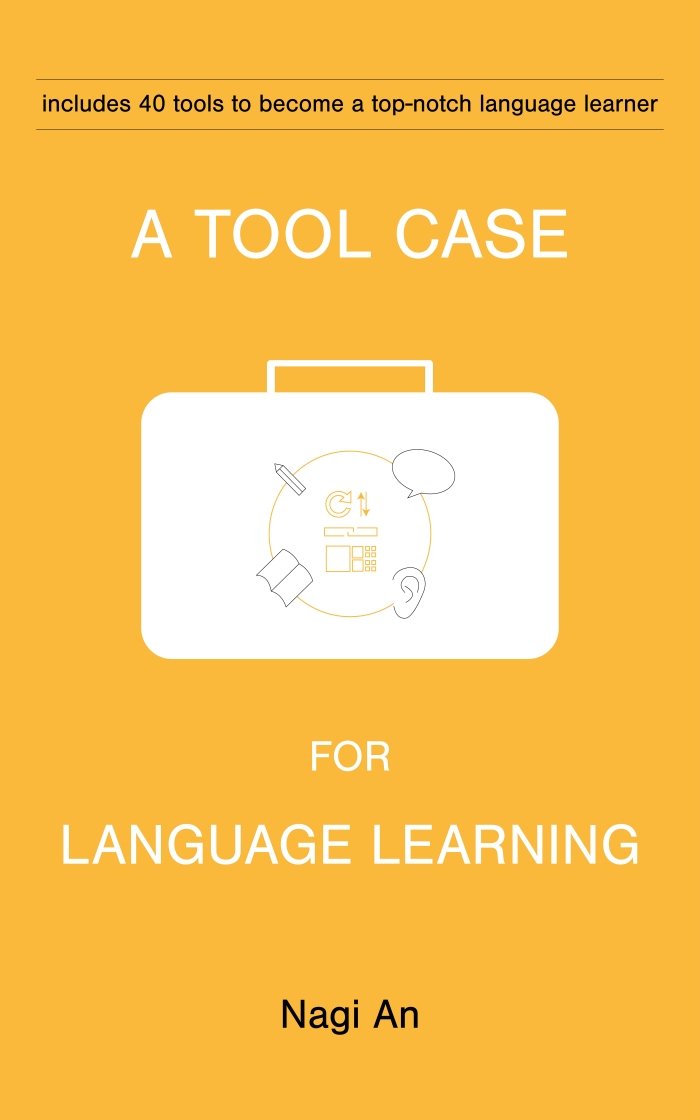A Tool Case For Language Learning:
40 Tools to Become a Top-Notch Language Learner
by Nagi An

Learn how you should be learning a language the right way!
You can approach language learning from many different perspectives. You may think that the best way to learn is through immersion and seek an opportunity to live in a foreign country for a while. Maybe you are good at memorizing lists and therefore tend to learn best by applying mnemonics techniques. Some learn via song, some prefer flashcards, and others learn by watching movies with subtitles. Other approaches include keeping a diary to reflect upon your performance and reading a lot of material in the target language.
Until we know what other techniques or tools exist beyond what we already know or apply, we can’t be sure that we are learning in the way that suits us best. It’s essential to experiment with tools we haven’t tried before to determine the most effective ways for us to learn.
In this book, there are 40 such tools for learning languages. The aim is to show you why, how, and when certain tools work, and to give you a thorough understanding of the techniques you can employ as you are learning languages.
Try them all, experiment with them, and mix and match to create a personalized process for yourself.
You are different from other language learners. That’s why your learning path should be different, too.
Build a language learning path that is right for you.
From the San Francisco Book Review:
It’s easy to get stuck in a rut, especially when it comes to how we approach learning new things. Yet if we do not experiment with learning methods, how can we truly know that we’re getting optimal results?
In A Tool Case for Language Learning: 40 Tools to Become a Top-Notch Language Learner, author Nagi An provides readers with a wide variety of tools to utilize when learning a new language. “People learn in different ways and for different reasons,” An writes. “Until we know what other techniques or tools exist beyond what we already know or apply, we can’t be sure that we are learning in the way that suits us best.”
The first part of this reference guide is designed for beginning language learners, focusing on vocabulary acquisition, and the second offers more advanced speakers ideas for improving their reading, writing, and conversational skills. The tools and techniques are based on what the author used as she was learning German, Spanish, English, and Japanese.
The author offers sound advice and backs it up with scientific studies as well as useful examples. And she advises learners to try a variety of tools and to mix and match them in order to create a personalized learning process. In Utilizing Tool Number 1, An recommends looking for ways to group vocabulary words by theme or family. Smaller chunks are easier to memorize than long lists.
The Feynman Technique, Tool Number 15, is brilliant. Choose a topic, learn about it, then articulately explain the concept to yourself or to another person in clear, straightforward language. If you’re unable to do so, you do not thoroughly understand the subject and need to learn more. The process starts again.
Tool Number 35 is one of my favorites: making mistakes as a speaking technique. “If you want to become fluent, perfectionism can be your enemy,” An writes. “Start making mistakes as early as possible, as this will allow you to get early feedback to learn from.”
A Tool Case for Language Learning offers helpful advice for anyone learning a new language. While some professional formatting and copyediting are suggested, it’s an easy read offering excellent advice. I would recommend it to students and teachers alike, as it significantly expands the memory tools available to them at home or in the classroom. An’s techniques are useful and scientifically sound. One could take these tools and successfully master any new subject they set their mind to.
Reviewed by Jennifer Melville
Purchase book through Amazon.
Author Bio
I’m committed to understanding how we learn and create in adulthood. On the one hand, by increasing awareness of effective learning strategies, we can learn faster. Experimenting with different tools allows us to unleash what works best for us. On the other hand, the most desired outputs of learning are exploring and creating. That’s why I do research in both areas – how knowledge building and understanding work, and how we can improve skills like ideation, analyzing and evaluating – so that we can be more productive and creative. I write books and design courses based on the findings of my research, trips I take and experiments I carry out on my small business. To read nuggets of my current work, you can visit www.bynagi.com
